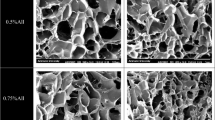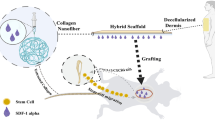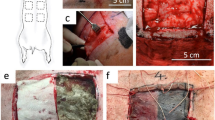Abstract
Restoring the physiological function of the damaged skin is crucial due to its undeniable protective role as well as its aesthetic aspects. Herein, a novel bilayer freeze-dried scaffold comprised of allograft collagen and glycosaminoglycan (Col-GAG; the biocompatible inner layer) adhered to silicone (mechanically reinforcing component) utilizing gelatin as the bio-glue was prepared to benefit from each origin (human-derived and synthetic) advantages. The structural characterizations of the scaffolds were analyzed by X-ray Diffraction (XRD), Scanning Electron Microscopy (SEM), tensile stress test, water uptake behavior, and Water Vapor Permeability (WVP). Also, the scaffolds' cytocompatibility was assessed by culturing human dermal fibroblasts (HDF) on the samples. Furthermore, the in vivo functionality was performed by implanting the scaffolds in male mice and observing the cellularization as well as neovascularization by Hematoxylin and Eosin (H&E) staining and CD31 marker. Based on the results, the potentially amorphous scaffolds were three-dimensional (3D) porous with randomly oriented interconnected pores suitable for cellular ingrowth. The application of the silicone layer resulted in resisting the extra osmotic pressure of water molecules by decreasing the water uptake ratio to 59.2 ± 0.33%, maintaining the WVP at an approximate rate of 0.1–10 mg/cm2hr, and boosting the tensile strength to 1.66 ± 0.12 MPa. The grafts provided an optimum environment for cell attachment and presented cellular viability upper than 70% after 72h. In vivo assessment exhibited improved perivascular localization, with the cell migration rate approximating 64%. The outcomes indicated that the achieved scaffold holds promise as an ideal wound dressing.












Similar content being viewed by others
Data Availability
All data generated or analyzed during this study are included in this published article (and its supplementary information files).
References
Nguyen HM, Le TTN, Nguyen AT, Le HNT, Pham TT (2023) Biomedical materials for wound dressing: recent advances and applications. RSC Adv 13:5509–5528
Tottoli EM, Benedetti L, Chiesa E, Pisani S, Bruni G, Genta I, Conti B, Ceccarelli G, Dorati R (2023) Electrospun naringin-loaded fibers for preventing scar formation during wound healing. Pharmaceutics 15:747
Jiang J, Li X, Li H, Lv X, Xu Y, Hu Y, Song Y, Shao J, Li S, Yang D (2023) Recent progress in nanozymes for the treatment of diabetic wound. J Mater Chem B 11:6746–6761
Flohr CRH (2021) Putting the burden of skin diseases on the global map. Blackwell, UK
Zhang M, Xu S, Du C, Wang R, Han C, Che Y, Feng W, Wang C, Gao S, Zhao W (2023) Novel PLCL nanofibrous/keratin hydrogel bilayer wound dressing for skin wound repair. Colloids Surf B 222:113119
Holloway S, Harding KG (2022) Wound dressings. Surg Infect (Larchmt) 40:25–32
Rezaei H, Shahrezaee M, Jalali Monfared M, Ghorbani F, Zamanian A, Sahebalzamani M (2021) Mussel-inspired polydopamine induced the osteoinductivity to ice-templating PLGA–gelatin matrix for bone tissue engineering application. Biotechnol Appl Biochem 68:185–196
Dhivya S, Padma VV, Santhini E (2015) Wound dressings–a review. Biomedicine 5:22
Hopf HW, Humphrey LM, Puzziferri N, West JM, Attinger CE, Hunt TK (2001) Adjuncts to preparing wounds for closure: hyperbaric oxygen, growth factors, skin substitutes, negative pressure wound therapy (vacuum-assisted closure). Foot Ankle Clin 6:661–682
Kelangi SS, Theocharidis G, Veves A, Austen WG, Sheridan R, Goverman J, Bei M (2020) On skin substitutes for wound healing: current products, limitations, and future perspectives. Technology 8:8–14
Vig K, Chaudhari A, Tripathi S, Dixit S, Sahu R, Pillai S, Dennis VA, Singh SR (2017) Advances in skin regeneration using tissue engineering. Int J Mol Sci 18:789
Sorushanova A, Delgado LM, Wu Z, Shologu N, Kshirsagar A, Raghunath R, Mullen AM, Bayon Y, Pandit A, Raghunath M (2019) The collagen suprafamily: from biosynthesis to advanced biomaterial development. Adv Mater 31:1801651
Cazzell S, Moyer PM, Samsell B, Dorsch K, McLean J, Moore MA (2019) A prospective, multicenter, single-arm clinical trial for treatment of complex diabetic foot ulcers with deep exposure using acellular dermal matrix. Adv Skin Wound Care 32:409
Carvalho-Júnior JD, Zanata F, Aloise AC, Ferreira LM (2021) Acellular dermal matrix in skin wound healing in rabbits-histological and histomorphometric analyses. Clinics 76:e2066
Tognetti L, Pianigiani E, Ierardi F, Lorenzini G, Casella D, Liso FG, De Pascalis A, Cinotti E, Rubegni P (2021) The use of human acellular dermal matrices in advanced wound healing and surgical procedures: state of the art. Dermatol Ther 34:e14987
Bondioli E, Purpura V, Orlandi C, Carboni A, Minghetti P, Cenacchi G, De Luca G, Capirossi D, Nigrisoli E, Melandri, D (2019) The use of an acellular matrix derived from human dermis for the treatment of full-thickness skin wounds. Cell Tissue Banking 20:183–192
Mucina L, Rutherford MC (2006) The vegetation of South Africa, Lesotho and Swaziland. South African National Biodiversity Institute, South Africa, Pretoria
Solarte David VA, Güiza-Argüello VR, Arango-RodríguezSossaBecerra-Bayona MLCLSM (2022) Decellularized tissues for wound healing: towards closing the gap between scaffold design and effective extracellular matrix remodeling. Front Bioeng Biotechnol 10:821852
Huimin X, Xin C, Xuanzhe L, Gen W, Yu Y (2023) Recent advances in decellularized biomaterials for wound healing. Mater Today Bio 19:100589
Bahrami S, Baheiraei N, Shahrezaee M (2021) Biomimetic reduced graphene oxide coated collagen scaffold for in situ bone regeneration. Sci Rep 11:16783
Xu R, Luo G, Xia H, He W, Zhao J, Liu B, Tan J, Zhou J, Liu D, Wang Y (2015) Novel bilayer wound dressing composed of silicone rubber with particular micropores enhanced wound re-epithelialization and contraction. Biomaterials 40:1–11
Barrett S, King B, Welch D, Scales A, Nockels S (2022) A next generation silicone foam wound dressing. A 51-wound clinical evaluation. Wound Pract Res 30:228
Tottoli EM, Dorati RA-O, Genta IA-O, Chiesa E, Pisani S, Conti BA-O (2020) Skin wound healing process and new emerging technologies for skin wound care and regeneration. Pharmaceutics 12:735
John E, Kemnitzer EP. Process for preparing tissue regeneration matrix. Integra Lifesciences Corp, United States, US20160143726A1. (2015)
Fonseca DF, Carvalho JP, Bastos V, Oliveira H, Moreirinha C, Almeida A, SilvestreVilelaFreire AJCCS (2020) Antibacterial multi-layered nanocellulose-based patches loaded with dexpanthenol for wound healing applications. Nanomaterials 10:2469
Liao W, Duan X, Xie F, Zheng D, Yang P, Wang X, Hu Z (2023) 3D-bioprinted double-crosslinked angiogenic alginate/chondroitin sulfate patch for diabetic wound healing. Int J Biol Macromol 236:123952
Sousa MP, Neto AI, Correia TR, Miguel SP, Matsusaki M, Correia Mano IJJF (2018) Bioinspired multilayer membranes as potential adhesive patches for skin wound healing. Biomater Sci 6:1962–1975
Yang C, Ding X, Yang C, Shang L, Zhao Y (2023) Marine polymers-alginate/chitosan composited microcapsules for wound healing. Chem Eng J 456:140886
Kataria K, Gupta A, Rath G, Mathur R, Dhakate S (2014) In vivo wound healing performance of drug loaded electrospun composite nanofibers transdermal patch. Int J Pharm 469:102–110
Shi Y, Ma L, Zhou J, Mao Z, Gao C (2005) Collagen/chitosan-silicone membrane bilayer scaffold as a dermal equivalent. Polym Adv Technol 16:789–794
Chang Y, Cheah PC, Seow (2000) Plasticizing—antiplasticizing effects of water on physical properties of tapioca starch films in the glassy state. J Food Sci 65:445–451
Anggorowati N, Kurniasari CR, Damayanti K, Cahyanti T, Widodo I, Ghozali A, Romi MM, SariN DCR, Arfian, (2017) Histochemical and immunohistochemical study of α-SMA, collagen, and PCNA in epithelial ovarian neoplasm. Asian Pacific journal of cancer prevention: APJCP 18:667
Petrie K, Cox CT, Becker BC, MacKay BJ (2022) Clinical applications of acellular dermal matrices: a review. Scars Burns Healing. https://doi.org/10.1177/20595131211038313
Kirsner RS, Bohn G, Driver VR, Mills JL Sr, NanneyWilliamsWu LBMLSC (2015) Human acellular dermal wound matrix: evidence and experience. Int Wound J 12:646–654
Ghettia M, Bondioli E, Purpura V, Cenacchi G, Ruscelli PD, Melandri (2017) Decellularized human dermal matrix produced by a skin bank. Ann Ital Chir 88:443–448
Bondioli E, Fini M, Veronesi F, Giavaresi G, Tschon M, Cenacchi G, Cerasoli S, GiardinoMelandri RD (2014) Development and evaluation of a decellularized membrane from human dermis. J Tissue Eng Regen Med 8:325–336
Wittaya-areekul SCP (2006) Development and in vitro evaluation of chitosan–polysaccharides composite wound dressings. Int J Pharm 313:123–128
Gao Y, Wang J, Liang X, Yan Z, LiuCai YY (2014) Investigation on permeation properties of liquids into HTV silicone rubber materials. IEEE Trans Dielectr Electr Insul 21:2428–2437
Sizeland KH, Hofman KA, Hallett IC, Martin DE, Potgieter J, Kirby NM, Hawley A, Mudie ST, RyanHaverkampCumming TMRGMH (2018) Nanostructure of electrospun collagen: Do electrospun collagen fibers form native structures? Materialia 3:90–96
David G, Cristea M, Balhui C, Timpu D, DorofteiSimionescu FBC (2012) Effect of cross-linking methods on structure and properties of poly (ε-caprolactone) stabilized hydrogels containing biopolymers. Biomacromol 13:2263–2272
Chang HI, Wang Y (2011) In: regenerative medicine and tissue engineering-cells and biomaterials. InTechOpen, London
Haidar NB, Marais S, Dé E, Schaumann A, Barreau M, FeuilloleyDuncan MGAC (2020) Chronic wound healing: a specific antibiofilm protein-asymmetric release system. Mater Sci Eng, C 106:110130
Azimi B, Maleki H, Zavagna L, De la Ossa JG, Linari S, LazzeriS A, Danti, (2020) Bio-based electrospun fibers for wound healing. J Funct Biomater 11:67
Zulkiflee I, Masri S, Zawani M, Salleh A, Amirrah IN, Wee MFMR, YusopFauzi SMMB (2022) Silicon-based scaffold for wound healing skin regeneration applications: a concise review. Polymers 14:4219
Pires ALRÂMM (2015) Improvement of the mechanical properties of chitosan-alginate wound dressings containing silver through the addition of a biocompatible silicone rubber. J Appl Polym Sci 132:41686
Ratner BD, Hoffman AS, SchoenLemons FJJE (2004) Biomaterials science: an introduction to materials in medicine. Elsevier, Netherlands
Farshi P, Salarian R, Rabiee M, Alizadeh S, Gholipourmalekabadi M, AhmadiRabiee SN (2022) Design, preparation, and characterization of silk fibroin/carboxymethyl cellulose wound dressing for skin tissue regeneration applications. Polym Eng Sci 62:2741–2749
Eskandarinia A, Kefayat A, Agheb M, Rafienia M, Amini Baghbadorani M, Navid S, Ebrahimpour K, Khodabakhshi D, Ghahremani F (2020) A novel bilayer wound dressing composed of a dense polyurethane/propolis membrane and a biodegradable polycaprolactone/gelatin nanofibrous scaffold. Sci Rep 10:3063
Ren P, Zhang H, Dai Z, Ren F, Wu Y, Hou R, Zhu YJ, Fu (2019) Stiff micelle-crosslinked hyaluronate hydrogels with low swelling for potential cartilage repair. J Mater Chem B 7:5490–5501
Nuutila KE (2021) Eriksson moist wound healing with commonly available dressings. Adv Wound Care 10:685–698
Zhu B, Li W, Chi N, Lewis RV, Osamor J, Wang R (2017) Optimization of glutaraldehyde vapor treatment for electrospun collagen/silk tissue engineering scaffolds. ASC Omega 2:2439–2450
Lan G, Zhu S, Chen D, Zhang H, ZouZeng LY (2021) Highly adhesive antibacterial bioactive composite hydrogels with controllable flexibility and swelling as wound dressing for full-thickness skin healing. Front Bioeng Biotechnol 2:785302
Deutsch C, Edwards DS, Myers (2017) Wound dressings. Br J Hosp Med 78:C103–C109
Wiegand C, Tittelbach J, Hipler UC, Elsner P (2015) Clinical efficacy of dressings for treatment of heavily exuding chronic wounds. Chronic Wound Care Manag Res 10:101–111
Akrami-Hasan-Kohal M, Tayebi LM, Ghorbani (2020) Curcumin-loaded naturally-based nanofibers as active wound dressing mats: Morphology, drug release, cell proliferation, and cell adhesion studies. New J Chem 44:10343–10351
Xu R, Xia H, He W, Li Z, Zhao J, Liu B, Wang Y, Lei Q, KongBai YY (2016) Controlled water vapor transmission rate promotes wound-healing via wound re-epithelialization and contraction enhancement. Sci Rep 6:24596
Yannas IV, Burke JF (1985) Method of using a fibrous lattice. Massachusetts Institute of Technology, United States, US4505266A
Gao Z, Su C, Wang C, Zhang Y, Wang C, YanHou HG (2021) Antibacterial and hemostatic bilayered electrospun nanofibrous wound dressings based on quaternized silicone and quaternized chitosan for wound healing. Eur Polymer J 159:110733
López-García J, Lehocký M, Humpolíček P, Sáha P (2014) HaCaT keratinocytes response on antimicrobial atelocollagen substrates: extent of cytotoxicity, cell viability and proliferation. J Funct Biomater 5:43–57
Yang J, Liang G, Xiang T, Situ W (2021) Effect of crosslinking processing on the chemical structure and biocompatibility of a chitosan-based hydrogel. Food Chem 354:129476
Sodhi HAP (2020) Glycosaminoglycans in tissue engineering: a review. Biomolecules 11:29
Lepedda AJ, Nieddu G, Formato M, Baker MB, Fernandez-Perez J, Moroni L (2021) Glycosaminoglycans: from vascular physiology to tissue engineering applications. Front Chem 9:680836
Rouet V, Hamma-Kourbali Y, Petit E, Panagopoulou P, Katsoris P, Barritault D, Caruelle J-P, Courty J (2005) A synthetic glycosaminoglycan mimetic binds vascular endothelial growth factor and modulates angiogenesis. J Biol Chem 280:32792–32800
Nita M, Pliszczyński J, Kowalewski C, Woźniak K, Eljaszewicz A, Moniuszko M, Kamiński A, Śladowski D, Zimek Z, Majewski S (2020) New treatment of wound healing with allogenic acellular human skin graft: preclinical assessment and in vitro study. Transpl Proc 52:2204–2207
Chen K, Pan H, Ji D, Li Y, Duan H, Pan W (2021) Curcumin-loaded sandwich-like nanofibrous membrane prepared by electrospinning technology as wound dressing for accelerate wound healing. Mater Sci Eng, C 127:112245
Lee DW, Lee MC, RohLee HWJ (2014) Multilayered implantation using acellular dermal matrix into nude mice. J Mater Sci - Mater Med 25:2669–2676
Funding
This research was supported financially by the Iran National Science Foundation (INSF) under Grant Number 4003142, with partial support from the Iranian Tissue Product Company.
Author information
Authors and Affiliations
Contributions
All authors contributed in preparing the bilayer wound dressing. FF and HM performed the characterizations and ST analyzed the data and prepared the outcomes. ST and FF wrote and revised the main manuscript text (equally as the first author) with partial contribution of HM. NB, RS, and AT reviewed the manuscript. Also, NB monitored the whole process.
Corresponding authors
Ethics declarations
Conflict of interest
The authors declare that they have no conflict of interest.
Ethical Approval
Animal investigations were approved by the Ethics Committee of Tarbiat Modares University, Iran (IR.MODARES.AEC.1402.013).
Additional information
Publisher's Note
Springer Nature remains neutral with regard to jurisdictional claims in published maps and institutional affiliations.
Rights and permissions
Springer Nature or its licensor (e.g. a society or other partner) holds exclusive rights to this article under a publishing agreement with the author(s) or other rightsholder(s); author self-archiving of the accepted manuscript version of this article is solely governed by the terms of such publishing agreement and applicable law.
About this article
Cite this article
Forouzandeh, F., Tabatabaee, S., Baheiraei, N. et al. Bilayer Wound Dressing Composed of Allograft Collagen-Glycosaminoglycan and Silicone: Synthesis, Characterization and Biological Behavior. J Polym Environ (2023). https://doi.org/10.1007/s10924-023-03095-3
Accepted:
Published:
DOI: https://doi.org/10.1007/s10924-023-03095-3




